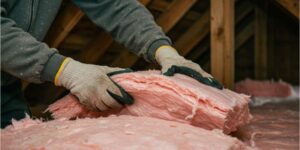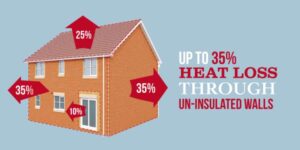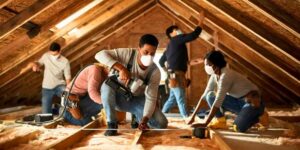Did you know that heating and cooling account for nearly half of a home’s energy use? This winter, don’t let your hard-earned money escape through drafty windows and inefficient systems? You don’t have to choose between staying warm and staying within your budget. Here are some tips and tricks to help you stay cozy and eco-friendly this winter.
Simple Ways to Slash Your Energy Bills and Stay Cozy Year-Round
Heating and cooling can account for almost half of a home’s total energy consumption, making it a significant expense for homeowners. But what if you could stay comfortable year-round while reducing your energy bills and minimizing your environmental impact? By implementing a few simple changes and upgrades, you can transform your home into a haven of energy efficiency. Let’s explore some practical tips to help you save money and stay cozy, regardless of the season.

Effective Insulation: Your Home’s Winter Coat.
Imagine insulation as a warm winter coat for your house, preventing precious heat from escaping during the chilly months and keeping cool air inside during the scorching summer. Proper insulation is essential for maintaining a comfortable temperature and minimizing energy waste. Insulation acts as a barrier to heat flow, lowering your heating and cooling costs. It’s not just about comfort; it’s a smart financial move that can lead to lower utility bills and long-term cost savings.

How Insulation Works.
Insulation materials have unique properties that combat specific heat transfer methods. They create a thermal barrier that reduces the rate at which heat escapes or enters your home. This means your heating and cooling system doesn’t have to work as hard to maintain the desired temperature, leading to improved efficiency and potentially extending the lifespan of your HVAC (Heating, Ventilation, and Air Conditioning) systems that regulate your home’s temperature.
Where Does Heat Escape?
Before you start adding insulation, it’s crucial to identify the areas where heat might be escaping. Common culprits include:
- Attic: Heat naturally rises, making the attic a prime spot for energy loss.
- Walls: Poorly insulated walls can lead to significant heat transfer, especially in older homes.
- Floors: Especially in homes with crawl spaces or basements, floors can be a major source of heat loss.
- Windows and Doors: Cracks and gaps around windows and doors allow drafts to steal your heat.

Insulation Options
There are various types of insulation available, each with its own pros and cons. Some popular choices include:
- Fiberglass: This classic insulation comes in batts or rolls and is a cost-effective option for DIYers.
- Cellulose: Made from recycled paper, cellulose is an environmentally friendly choice with excellent insulating properties.
- Spray Foam: This expanding foam seals cracks and gaps, providing superior insulation and air sealing.
DIY Insulation Tips
For those who enjoy tackling home improvement projects, here are some DIY insulation tips:
- Attic Insulation: Adding insulation to your attic is a relatively easy DIY project. Roll out batts between the joists or consider blown-in insulation for added coverage.
- Caulking and Weatherstripping: Seal air leaks around windows and doors with caulk and weatherstripping. This simple step can make a big difference in your energy bills. For more complex insulation needs, such as insulating walls or crawl spaces, it’s best to consult with a professional insulation contractor. They can assess your home’s specific needs and recommend the most effective solutions.

Thermostat Settings: The Climate Control Command Center
Your thermostat is like the pilot of your home’s energy usage. Using it strategically can translate into significant savings.
Here’s a general guideline for energy-efficient thermostat settings:
- Summer: When you’re home, set your thermostat to 78°F or higher. When you’re away or asleep, set it to 85°F or higher.
- Winter: When you’re awake and at home, set your thermostat to 68°F to 70°F. When you’re asleep or away, set it to 60°F to 63°F.
You might be surprised at how easily you can achieve these energy-saving temps. Remember, it won’t take longer to warm up your home from the lower temps! These small adjustments will lower your overall heat loss and save money. Imagine what you can do with the extra dollars saved!
Programmable Thermostats: If you’re ready to upgrade, consider a highly rated programmable thermostat. These devices allow you to set different temperatures for different times of the day, ensuring your home is comfortable when you need it and saving energy when you don’t. In addition to energy savings, programmable thermostats can also help extend the lifespan of your HVAC equipment by reducing the overall runtime of your system.

Smart Thermostats: Smart thermostats take energy savings to the next level. They learn your preferences and adjust the temperature accordingly. They can also be controlled remotely via your smartphone, giving you ultimate control over your home’s climate. Smart thermostats can lead to significant cost savings by learning user patterns and optimizing heating and cooling schedules. They can even reduce consumption at times of peak energy use, further maximizing your savings.
Draft-Proofing: Stopping Energy Thieves in Their Tracks
Drafty windows and doors are like tiny energy thieves, constantly letting your heated or cooled air escape. Even small drafts can significantly impact energy consumption and comfort, making it essential to seal them up. We have to catch these thieves!
Finding Drafts:
Here are some ways to identify drafts:
- Visual Inspection: Look for gaps and cracks around windows, doors, and other openings.
- The Candle Test: Start by identifying drafts with the candle test (click the link for a short video on the candle test). Once you’ve identified some draft sources, clean the area around the cracks, apply weatherstripping, and use caulk to seal the opening.
- The Money Test: If you can easily slide a piece of paper money under an exterior door, you likely have an air leak.
- Wind Meter: For a more precise measurement of airflow, use a wind meter to pinpoint the exact location and severity of drafts.
Sealing Drafts
Once you’ve identified the drafts, it’s time to seal them up. Here are some DIY solutions:
- Weatherstripping: Apply weatherstripping around windows and doors to create a tight seal.
- Caulking: Use silicone caulk, known for its weather sealing properties and ability to expand and contract with temperature changes, to seal cracks and gaps in window frames, door frames, and other areas.
- Door Sweeps/Draft Stoppers: Install door sweeps on exterior doors to block drafts at the bottom.
Energy-Efficient Appliances and Systems: Investing in Long-Term Savings
Upgrading to energy-efficient appliances and systems can be a significant investment, but it pays off in the long run with lower energy bills and a reduced environmental impact.
Heating and Cooling Systems:
Consider upgrading to a high-efficiency furnace, heat pump, or air conditioner. These systems use less energy to heat and cool your home, resulting in significant savings on your utility bills.
Smart Home Devices:
Smart home devices can play a crucial role in optimizing energy consumption.
- Smart Thermostats: As discussed earlier, smart thermostats learn your preferences and adjust the temperature accordingly, maximizing energy savings and comfort.
- Smart Plugs: Smart plugs allow you to control appliances remotely and prevent phantom loads, which are the energy consumed by electronics even when they are turned off.
- Smart Switches: Smart switches can be used to control not only lighting but also fans and other electrical appliances, enabling similar energy-saving benefits like scheduling and automatic turn-off.
Rebates and Incentives
Check for rebates and incentives that may be available for upgrading to energy-efficient appliances and systems. Many government agencies and utility companies offer programs to help homeowners make energy-efficient upgrades more affordable.
- Turn off lights when leaving a room. This age-old advice still holds true.
- Unplug electronics when not in use. Many electronics continue to draw power even when turned off, creating phantom loads.
- Use natural light whenever possible. Open curtains and blinds during the day to take advantage of free sunlight.
- Wash clothes in cold water. Most of the energy used to wash clothes goes towards heating the water.
- Air-dry clothes instead of using the dryer. Line drying or using a drying rack saves energy and can be gentler on your clothes.
- Take shorter showers. Heating water consumes a significant amount of energy.
- Use the microwave for cooking. Microwaves use less energy than conventional ovens, especially for small meals or reheating leftovers.
Energy-Efficient Lighting
Switching to energy-efficient lighting, such as LED bulbs, is one of the easiest and most effective ways to save energy. LEDs use up to 75% less energy and last much longer than traditional incandescent bulbs. They also produce less heat than traditional lighting, further increasing their efficiency. And unlike traditional bulbs, LEDs brighten up instantly when powered on.
Phantom Loads: The Silent Energy Drain
Many electronic devices and appliances continue to draw power even when they are turned off. This “phantom load” can account for a significant portion of your energy bill. To reduce phantom loads:
- Unplug devices when not in use. This is the most effective way to eliminate phantom loads.
- Use power strips. Plug multiple devices into a power strip and switch off the strip when not in use.
- Consider smart power strips. These advanced strips automatically cut power to idle electronics.
- Look for Energy Star products. Energy Star certified electronics have lower standby power consumption.
Energy-Saving Guides and Tutorials
For those who want to delve deeper into energy conservation, there are numerous resources available:
- Government websites: The U.S. Department of Energy and the Environmental Protection Agency offer comprehensive guides and tutorials on energy efficiency .
- Utility company websites: Many utility companies provide energy-saving tips and resources tailored to their customers. Connect with them via their website and social media.
- Online communities: Online forums and communities can be a valuable source of information and support for those interested in energy conservation. Find valuable resources and community support in online forums and groups. Join the conversation, share your journey, and help build a more energy-efficient world.
Government Agencies and Energy-Efficiency Programs
Several government agencies offer programs and incentives to help homeowners improve energy efficiency:
- U.S. Department of Energy: Offers the Weatherization Assistance Program to reduce energy costs for low-income households .
- Environmental Protection Agency: Partners with the Department of Energy on the Energy Star program, which promotes energy-efficient products and practices.
- State and local governments: Many state and local governments offer rebates, tax credits, and other incentives for energy-efficient upgrades.
Conclusion: A Brighter, More Efficient Future
By implementing these tips, you can create a more sustainable, comfortable home, and help protect our planet for future generations. Start with small changes, like turning off lights and unplugging devices, and gradually incorporate larger upgrades, such as insulation improvements or high-efficiency appliances, as your budget allows. And remember to focus on being
Take Action Today!
Start by conducting a home energy audit to identify areas for improvement. You can find resources and tools online or contact your local utility company for assistance.
PHYSICALLY STRONG … MENTALLY AWAKE … ENVIRONMENTALLY SAFE
Why is insulation so important for energy efficiency?
Insulation acts like a thermal barrier for your home, reducing the rate at which heat escapes in the winter and enters during the summer. This minimizes the workload on your heating and cooling systems, ultimately leading to lower energy bills and increased comfort. It’s crucial for maintaining a consistent temperature indoors, reducing the need for your HVAC system to constantly adjust, thus conserving energy and prolonging equipment lifespan. The main areas for heat loss are often the attic, walls, floors, and around windows and doors.
What are some easy ways to identify drafts in my home?
You can detect drafts using several simple methods. A visual inspection involves looking for gaps and cracks around windows, doors, and other openings. The candle test involves holding a lit candle near potential draft areas; if the flame flickers, there’s likely an air leak. You can also try the money test by seeing if you can easily slide a piece of paper money under an exterior door. For more precise measurements, a wind meter can help pinpoint draft locations and severity.
What are the recommended thermostat settings to save energy in the winter and summer?
During the winter, when you’re home and awake, aim for a thermostat setting between 68°F to 70°F. When you’re asleep or away, lower it to 60°F to 63°F. In the summer, set your thermostat to 78°F or higher when you’re home, and 85°F or higher when you’re away or asleep. Using a programmable or smart thermostat can automate these temperature changes throughout the day, further maximizing energy savings.
How can I effectively “draft-proof” my home on a budget?
You can seal drafts by using weatherstripping around windows and doors and caulking to seal cracks and gaps. Installing door sweeps on exterior doors can also help block drafts. Affordable products like foam, rubber, or felt weatherstripping, along with caulking and door sweeps, can significantly reduce air leaks. Consider using draft stoppers, which are long fabric tubes, at the bottom of doors as well.
What are the main benefits of upgrading to energy-efficient appliances and systems?
Upgrading to high-efficiency heating, cooling, and other appliances can result in lower utility bills. By consuming less energy to function, these systems reduce your overall consumption and cost, while minimizing environmental impact. In addition to major appliances, integrating smart home devices like smart thermostats, smart plugs and switches can improve efficiency by optimizing energy consumption and reducing phantom loads.
What are “phantom loads” and how can I minimize their impact on my energy consumption?
Phantom loads are the energy consumed by electronic devices and appliances even when turned off. To reduce them, unplug devices when not in use, use power strips to switch off multiple devices at once, or consider smart power strips that automatically cut power to idle electronics. Also, look for Energy Star-certified electronics that have lower standby power consumption.
Beyond home upgrades, what simple behavioral changes can lead to significant energy savings?
Many simple habits can impact energy usage. For example, turn off lights when leaving a room, unplug electronics when not in use, use natural light when possible, wash clothes in cold water, and air-dry clothes instead of using the dryer. Also, consider taking shorter showers and using a microwave instead of an oven whenever possible.
Where can I find resources and help with home energy efficiency?
There are numerous resources to help with energy conservation. Government websites like the U.S. Department of Energy and the Environmental Protection Agency offer comprehensive guides and tutorials on energy efficiency. Utility company websites provide energy-saving tips and resources tailored to their customers. You can also find information and support in online communities and forums dedicated to energy conservation. Additionally, look into state and local programs that offer rebates or incentives for energy-efficient upgrades.




